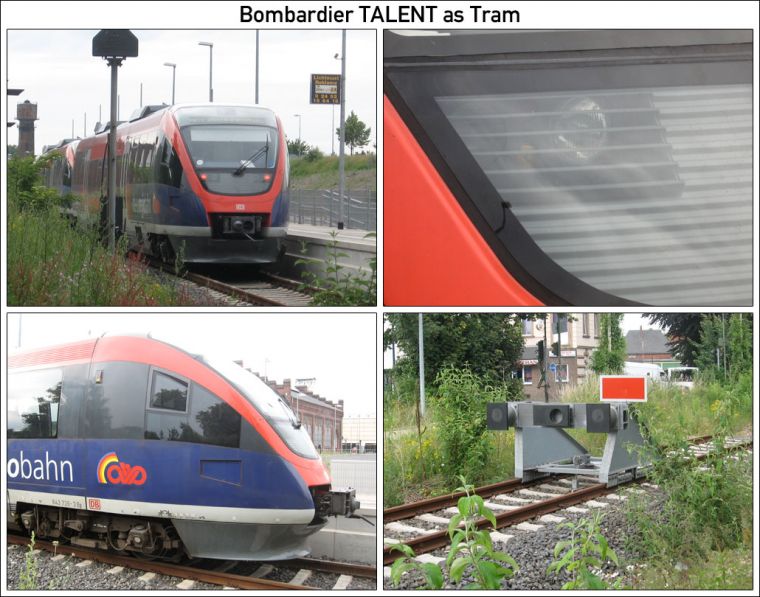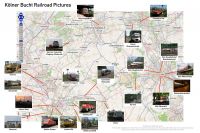Bombardier TALENT as Tram

Posted: 31 August 2008

This work is licensed under a Creative Commons Germany license.
Notes
We interrupt our regularly scheduled intermission for an actual submission. Notice that I still reserve the right to remain not very active here for the next month, thank you.
This is in reply to shenanigan87’s Portrait: Bombardier Talent, which shows you that this has been rather long in the planning. He says that the Bombardier TALENT is also available as a tram. That is only partly correct. As far as I know none of these DMUs is working as a streetcar anywhere. However, the TALENTs for the euregiobahn (always spelled in lower case) are equipped to be easily converted to a streetcar some time in the future, with additional brakes and other add-ons. The plan is that they’ll drive down into Aachen from the north-east (there is a freight-only railroad already in place that comes rather close to the city center) and the final meters to either Bushof (bus station) or Elisenbrunnen as a streetcar. Number 643 226 / 643 726 is an exception in that it was, as a test, already equipped with everything needed for tests, and it has retained most of this, so let’s take a closer look!
Here, it is standing in Alsdorf-Annapark station, as the trailing unit of a two-car train. I think the best possible description for how interesting Alsdorf-Annapark is is that the advertisement on the light pole only advertises advertisments on light poles.
Continuing, see the light cluster. To the left you have the red rear light, to the right the white front light. TALENTs don’t have special long-distance lights, so this is so far quite normal. What is unusual is the easy-to-spot yellow light between the two at the bottom, and the more difficult to spot red light above it. The yellow light is actually a signal indicator, and the red one is a brake light. All euregiobahn TALENTs have these.
Next, from the side you can see what separates 226/726 from it’s siblings. Between the driver’s window and the first passenger window, you’ll see that an additional light cluster has been placed containing additional marker lights and signal indicators. Normal euregiobahn TALENTs have a cover at this place that can probably be removed quite easily. At the bottom, you see a weird trapezoid hole. I have no idea what that does. All other members of the class have a cover there, while normal TALENTs are just smooth there. Finally, if you look hard, you can see three black dots and a faint black outline on the red beam, next to the seperation between the two lower sheets of glass of the front window. This is the place where a rear-view mirror was installed on this unit once and will be on all others.
Finally, one of life’s greatest mysteries solved: How does a buffer stop designed for two, well, buffers at either side of the train stop a train with a central coupling and no buffers? Well, like that. By end of 2010 at the latest this buffer stop will be gone, not for any mean reason but because the railroad track that comes behind it will be re-opened.
As for TALENTs as streectars, the current plan is that they’ll be driving into Aachen’s city center starting in 2015. I am rather doubtful whether this’ll actually happen. Nobody has money for that, and the route isn’t optimal either. The single road it’ll go down does not have any significant curves, which is good since I guess the minimum curve radius of the TALENT will be far less than an actual streetcar’s. However, there is lots of traffic jams there and no place for a dedicated right-of way. There is a bus lane, but only in one direction, and probably too narrow. Most importantly, the road goes through the town and specifically market place of Würselen, a city which has publicly expressed that it does not really wish for the crossing gates that this would entail. I’m kind of wondering why they don’t let the TALENT run in Würselen as a streetcar as well, but then it’d be stuck in the traffic jams that define Würselen to a large part.
The vehicle of the TALENT itself also poses problems. That it’s much heavier than a normal streetcar can probably be forgiven, but at 2.9 metres, it’s actually too wide to be legally used as a tram, so it has to get special permission. It also requires a 76 cm platform (which won’t be useful for buses anymore) for gap-free entry, which would probably be desired, and even with steps it can’t go below 30-something centimetres. That is quite low for a mainline railroad vehicle and less than, for example, Hanover’s LRV system, but far more than a low-floor streetcar.

 Deutsche Version
Deutsche Version Entire Gallery
Entire Gallery

 Next Picture
Next Picture
 Previous Picture
Previous Picture